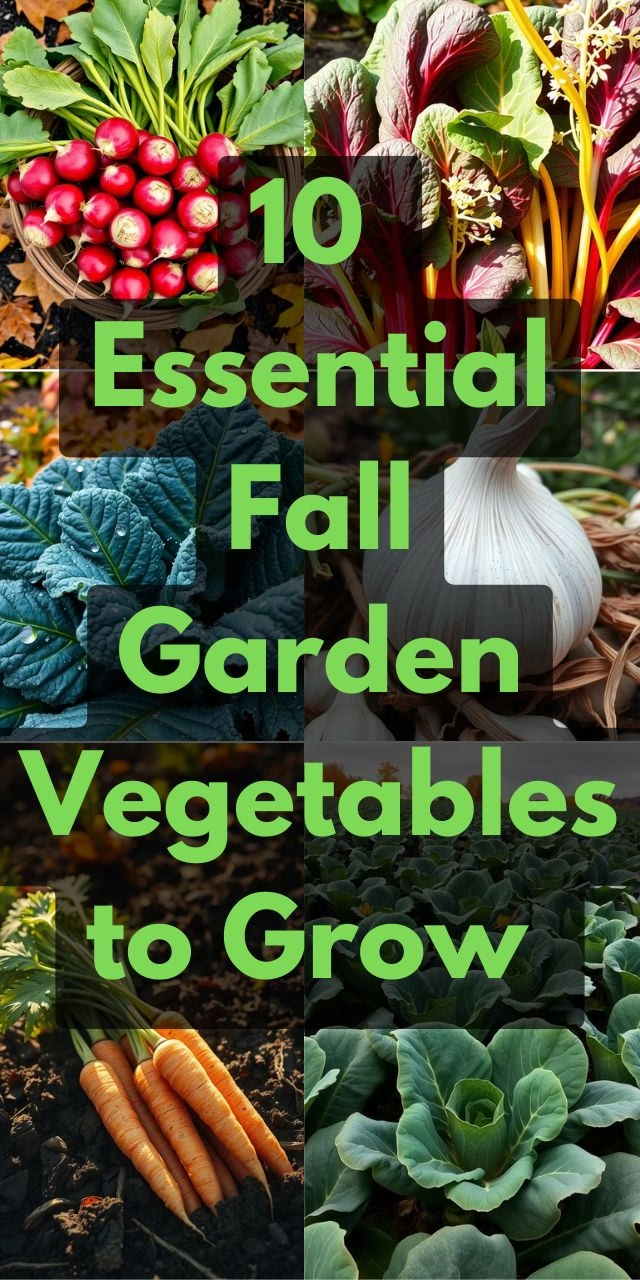Fall is a fantastic time to cultivate a garden full of hearty vegetables that thrive in cooler temperatures. Whether you’re a seasoned gardener or just starting out, there’s a variety of crops that can flourish during the fall months. Check out this list of 10 great fall garden vegetables to help you make the most of your autumn planting.
Brussels Sprouts
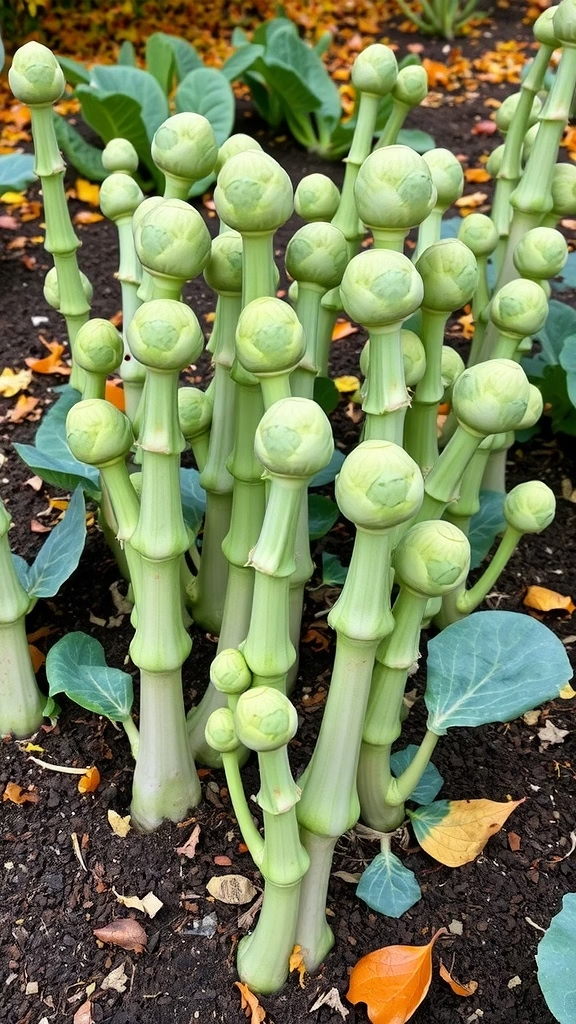
Brussels sprouts are a delightful addition to any fall garden. These unique, mini cabbage-like vegetables grow on tall stalks, making them quite a sight in the garden. The image shows clusters of Brussels sprouts, with their round, green heads ready for harvest. It’s hard to resist their charm!
As the weather cools, Brussels sprouts become sweeter and more flavorful. They thrive in the crisp fall air, which enhances their taste. When planting, choose a spot that gets plenty of sunlight and ensure the soil is well-drained.
Harvesting is easy too! Just twist or cut the sprouts from the stalk when they reach about 1 to 2 inches in diameter. You can enjoy them roasted, steamed, or even shredded in salads. They pair wonderfully with flavors like garlic and balsamic vinegar.
So, if you’re looking for a vegetable that stands out not just in taste but also in looks, Brussels sprouts are the way to go. They’ll bring a pop of color and a burst of flavor to your fall meals!
Kale

Kale is a true superstar of the fall garden. Its deep green leaves, often covered in sparkling droplets of water, look vibrant and fresh. This image captures the beauty of kale, surrounded by colorful plants that enhance its rich texture and color.
Growing kale is easy and rewarding. It thrives in cooler temperatures, making it perfect for fall. Plus, it can withstand frost, which often sweetens its flavor. You can enjoy kale in salads, soups, or even smoothies, adding a nutritious punch to your meals.
One of the best things about kale is its versatility. You can harvest young leaves for salads or let them grow larger for hearty dishes. Just rinse them well and toss them in your favorite recipe. Not only does it taste great, but it’s packed with vitamins and minerals that support good health.
Carrots
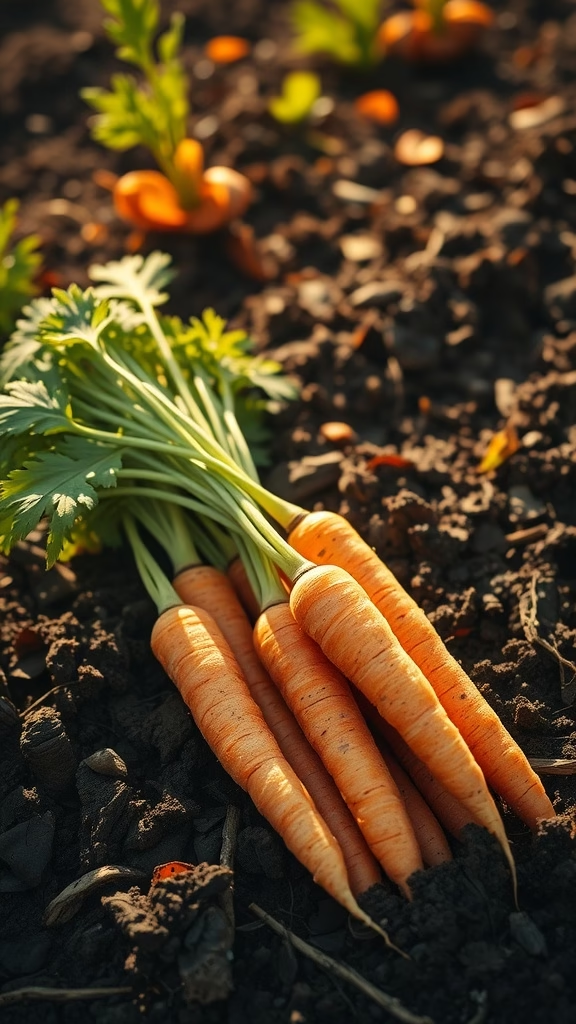
Carrots are a fantastic addition to your fall garden. Their bright orange color adds a cheerful touch to your garden beds, and they are surprisingly easy to grow. You can see a bunch of freshly harvested carrots in the image, complete with vibrant green tops. These healthy veggies thrive in cooler weather, making fall the perfect season for planting.
Carrots prefer loose, sandy soil that allows them to grow straight and long. They need plenty of water to develop properly, so keep the soil moist, but not soggy. Depending on the variety, you can expect to harvest them about 70 to 80 days after planting.
Not only are carrots delicious, but they are also packed with nutrients. They are a great source of beta-carotene, which is good for your eyes. You can enjoy them raw, roasted, or in soups and stews. With their sweet, earthy flavor, they are versatile in many fall recipes.
Spinach
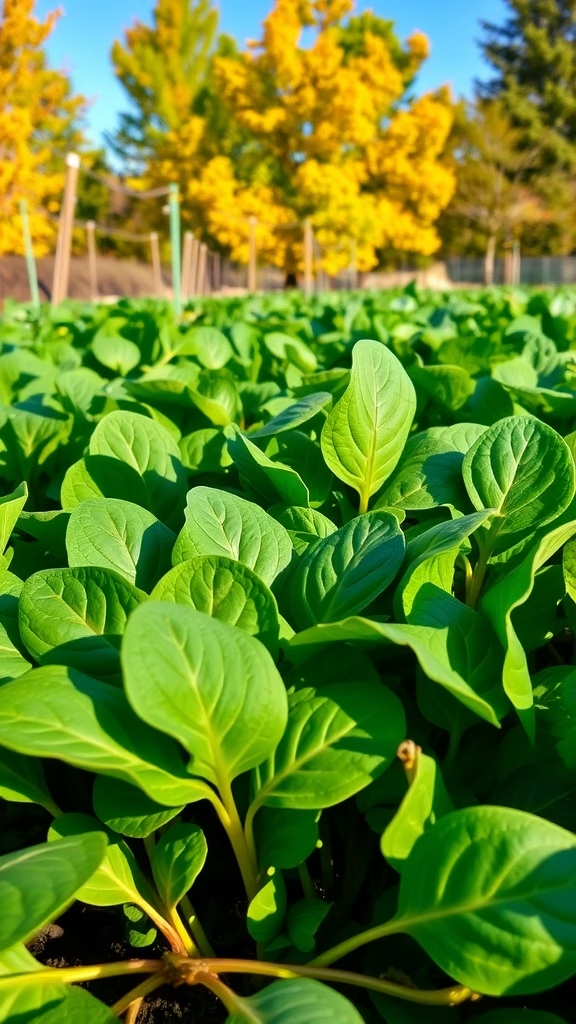
Spinach is a fantastic choice for fall gardens. The bright green leaves you see in the image are full of nutrients and flavor. This leafy vegetable thrives in cooler temperatures, making it perfect for autumn planting.
Growing spinach is pretty straightforward. Just plant the seeds in well-drained soil, and ensure they get enough sunlight. You’ll love how quickly they grow, often ready to harvest in just a few weeks. Plus, you can enjoy them fresh in salads or cooked in your favorite dishes.
As the leaves of spinach grow, they create a vibrant contrast against the backdrop of golden autumn foliage. This not only makes your garden look beautiful, but it also signifies a bountiful harvest. So, grab those seeds and get started on your fall spinach garden!
Radishes
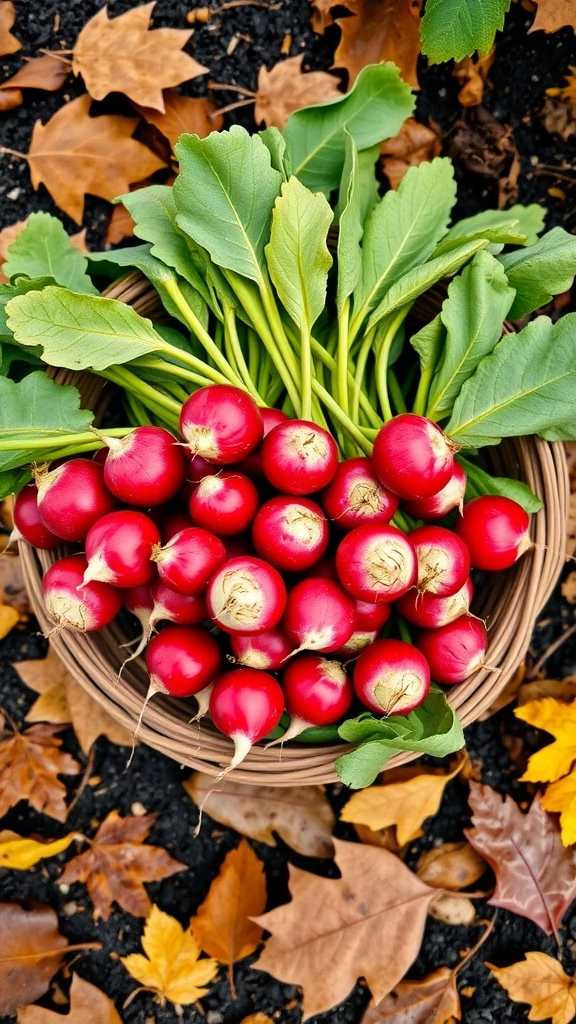
Radishes are a fun addition to any fall garden. They are easy to grow and add a nice crunch to your salads. The image shows a basket brimming with vibrant red radishes, surrounded by fallen autumn leaves. This scene highlights the beauty of harvesting fresh produce in the fall.
These colorful root vegetables are not just pretty; they come in various shapes and sizes, each offering a unique flavor. Their peppery taste can add a zing to many dishes. Whether you slice them for a salad, roast them for a warm side dish, or even pickle them for a tangy snack, radishes are versatile.
Growing radishes is a breeze. They thrive in cooler temperatures, making them perfect for fall planting. Just plant the seeds in well-drained soil, and in a few weeks, you’ll have a fresh crop ready to enjoy. Plus, they don’t require much space, making them ideal for small gardens or containers.
Beets

Beets are a fantastic addition to any fall garden. These colorful root vegetables bring a pop of vibrancy to your harvest and your meals. They grow well in cooler temperatures, making them perfect for fall planting.
In the image, you can see a beautiful bunch of freshly harvested beets, showcasing their deep purple skin and vibrant green tops. The earthy aroma of beets is a reminder of the rich soil they thrive in. Their leaves are also edible and can be used in salads or cooked dishes.
When it comes to cooking, beets are versatile. They can be roasted, boiled, or pickled. Their natural sweetness shines through when roasted, making them a great side dish or salad ingredient. Plus, they’re packed with nutrients, making them a healthy choice for any meal.
Growing beets is simple. Just sow the seeds in well-drained soil with plenty of sunlight. Water them regularly, and you’ll enjoy a bountiful harvest in no time. So, if you’re planning your fall garden, don’t forget to include beets!
Garlic
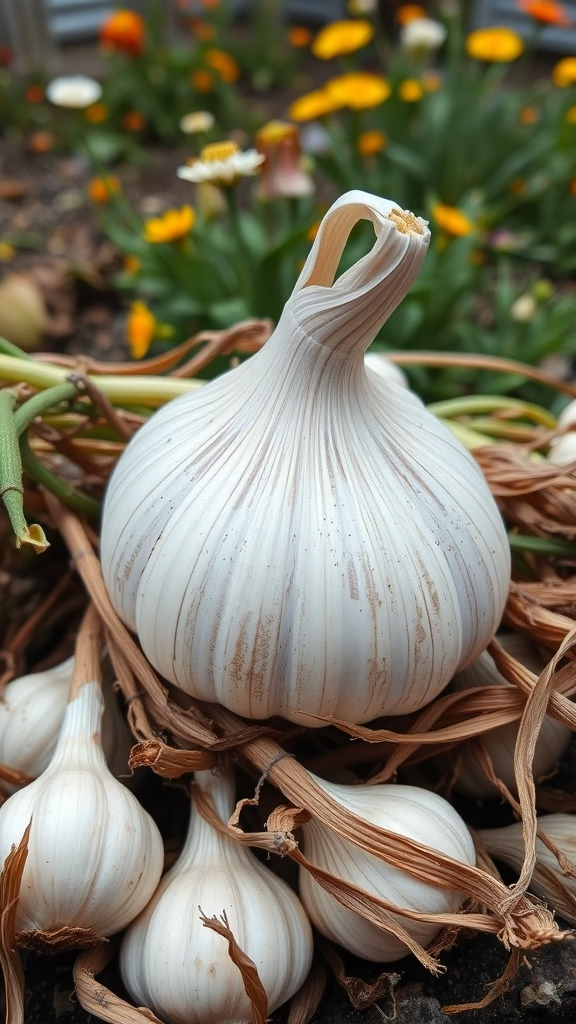
Garlic is a staple in many kitchens, known for its strong flavor and numerous health benefits. The image showcases beautiful bulbs of garlic, some of which are larger and surrounded by their smaller counterparts. The garlic in the foreground stands out, with its smooth, white skin and delicate roots.
Growing garlic in your fall garden is quite rewarding. It’s easy to plant and requires minimal effort to care for. Garlic thrives in well-drained soil and prefers a sunny spot. Plant the cloves in the fall, and they’ll be ready to harvest in the spring or early summer.
This vegetable isn’t just for cooking; it’s packed with nutrients. Garlic has been linked to various health benefits, including boosting immunity and reducing blood pressure. Plus, it adds a delicious kick to any dish!
When you’re ready to enjoy your homegrown garlic, there are countless ways to use it. Whether roasted, minced, or sautéed, it enhances flavors in soups, sauces, and marinades. Garlic truly is a versatile ingredient that no fall garden should be without.
Swiss Chard

Swiss chard is a colorful and nutritious addition to any fall garden. Its vibrant green leaves and striking red, yellow, and white stems create a stunning visual display. This leafy green is not just pretty; it’s packed with vitamins A, C, and K, making it a great choice for health-conscious gardeners.
Planting Swiss chard is easy. It thrives in cooler weather, so fall is perfect for sowing seeds directly into the soil. Make sure to pick a spot with plenty of sunlight and well-drained soil. Water regularly to keep the leaves lush and tender.
Harvesting Swiss chard can happen as soon as the leaves are big enough to eat. Simply cut the outer leaves at the base, allowing the inner leaves to continue growing. This way, you can enjoy fresh Swiss chard throughout the fall and even into winter.
There are many ways to enjoy Swiss chard in the kitchen. You can sauté it with garlic, toss it into salads, or even add it to soups. Its mild flavor pairs well with a variety of dishes, making it a versatile ingredient for any meal.
Collard Greens
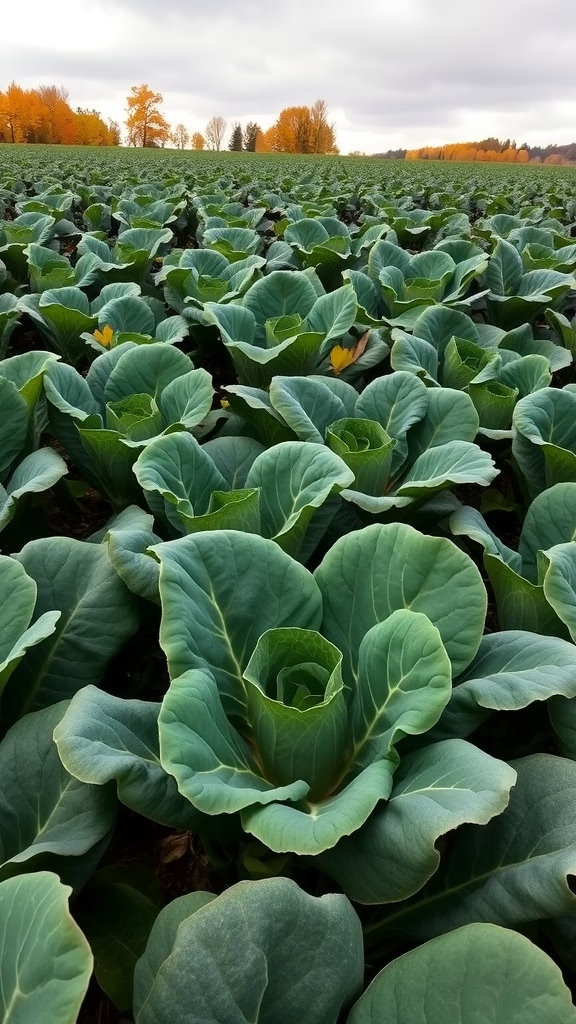
Collard greens are a fantastic choice for a fall garden. They thrive in cooler weather, making them perfect for planting as temperatures drop. This leafy green vegetable is not only nutritious but also versatile in the kitchen.
The image shows a lush field of collard greens, their broad, flat leaves standing tall. This vibrant green color indicates their freshness and health. In the background, trees adorn their fall colors, providing a beautiful contrast to the greens. You can almost feel the crisp autumn air!
Growing collard greens is relatively easy. They need a well-drained soil and a sunny spot. You can start them from seeds or buy young plants. Once established, they require regular watering, especially in dry spells.
In the kitchen, collard greens can be sautéed, steamed, or even used in soups. They are often cooked with garlic and oil or added to hearty stews. A classic recipe includes slow-cooked collard greens with smoked meat for a rich flavor. Try adding them to your next meal for a healthy boost!
Leeks
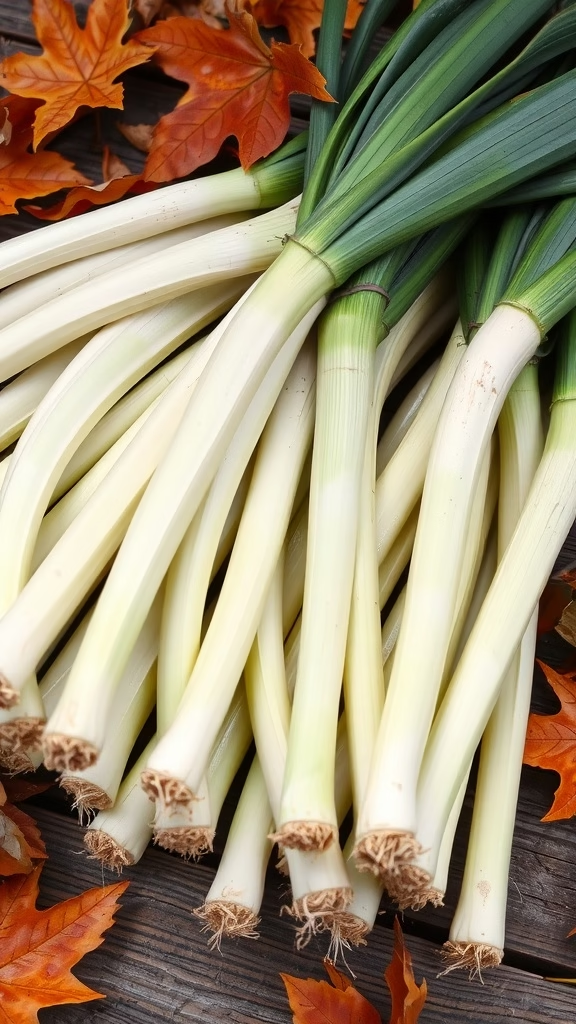
Leeks are a fantastic addition to any fall garden. Their mild onion flavor makes them a versatile ingredient in many dishes. These long, green vegetables have a unique appearance, with their white stalks and dark green tops. They thrive in cooler temperatures, making them perfect for autumn gardening.
When you look at a bunch of freshly harvested leeks, you can’t help but admire their crisp, straight stalks. The contrast between the white and green adds visual appeal to any garden. Plus, they are relatively easy to grow, requiring just a bit of care. They love well-drained soil and need regular watering to stay juicy.
In the kitchen, leeks shine in soups, stews, and even as a flavorful base for risottos. A classic dish is potato leek soup, which is creamy and comforting during chilly fall evenings. All you need are leeks, potatoes, broth, and a splash of cream. Chop them up, sauté, and let the flavors meld together.

